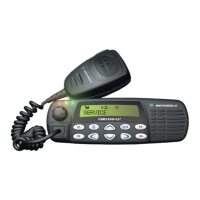Theory of Operation
2-25
2.
7 700 MHz Receiver Front-End
The 700 MHz receiver design is separated into two blocks, the front end and the back end. The
overall block diagram
of
the receiver is shown
in
Figure 2-11. Detailed descriptions
of
these stages
are contained in the paragraphs that follow.
Antenna
RF
Filter Amp
RX
from
If=\!
~
.
Antenna
Switch
____.,.
~
First
LO
from Synthesizer
RFAmp
Crystal
IF
Crystal
IF
Filter 1st Mixer
:~~~
-r
T
-=
Recovered
Aud
io~--._,
RSSI
....
~1-----i
L__
__
_____
_
Figure 2-11. 700 MHz Receiver Block Diagram
2.7.1 Receiver Front-End
T
The received signal from the antenna is routed through the harmonic filter and antenna switch and
applied to the antenna filter FL3000. This
is
a fixed-tuned 3-pole ceramic bandpass filter with a
passband
of
7 44 MHz to 766 MHz and an insertion loss
of
2.6 dB. The output
of
this filter is coupled
to RF amplifier
03001.
Diode CR3000 protects the RF amplifier by limiting excessive RF levels.
The output of the RF amplifier is applied to the
RF
amp filter FL3001, identical to FL3000. The
output
of
FL3001 is routed through a switchable local-distance attenuator consisting
of
R3013,
D3000,
03003
and associated components. Normally
03003
and D3000 are on and the receiver
sensitivity
is
at maximum. When
03003
and D3000 are off, the series resistor R3013 reduces
receiver sensitivity to minimize intermodulation when operating
in
the presence strong undesired
signals. The output
of
the local-distance attenuator is connected to the passive double-balanced
mixer consisting
of
components T3001, T3002, and CR3001. High-side injection from the frequency
synthesizer is band-pass
filtered by C3021-C3029 and L3008-9 to remove second harmonic energy
which may degrade half-IF spurious rejection performance, and applied to T3002 at a level
of
+18 dBm.
The
IF
output from T3002
is
applied to a diplexer (L3006-7, C3017-3020 and R3014) which matches
the 73.35 MHz
IF
signal to the crystal filter and terminates the mixer into
50n
at all other
frequencies.
2.7.2 Receiver Back-End
The receiver back end is a dual conversion design. The 73.35 MHz high
IF
consists
of
2-pole crystal
filter
FL31
01,
IF
amp
03101,
2-pole crystal filter FL3102 and
IF
amp
03102.
Each crystal filter has
a 3 dB bandwidth
of
9.0 kHz and a maximum insertion loss
of
2 dB. The output
of
03102
is
applied
to the input
of
the receiver IFIC U3101. Diode D3101 prevents overdriving the IFIC.

